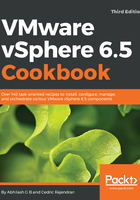
上QQ阅读APP看书,第一时间看更新
Getting ready
Before we learn to deploy PSC, it is important to understand that there is more than one deployment model supported by VMware. Although PSC can be deployed as an embedded service along with VCSA, VMware does not support the pairing of an embedded PSC instance with an external PSC. Therefore, it is important to decide on the deployment model before we proceed:
- Single PSC model: A single PSC servicing more than one vCenter. The PSC in this case is a single point of failure.
- Shared SSO domain PSC model: More than one PSC servicing the same SSO domain. Although the PSC is not a single point of failure, there is no automated failover if one of the PSCs fail. The PSCs can be of different SSO sites.
- PSCs behind a load balancer: More than one PSC servicing the same SSO domain and same SSO site. No single point of failure at the PSC layer. If one of the PSCs fails, then the load balancer will redirect future requests to the surviving PSC node. However, this requires the use of an NSX Edge or a third-party load balancer.
VMware supports the pairing of PSC instances regardless of the platform (appliance or Windows) they are deployed on.